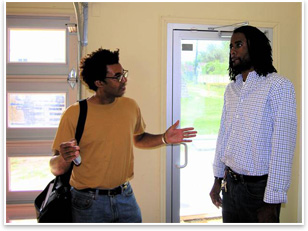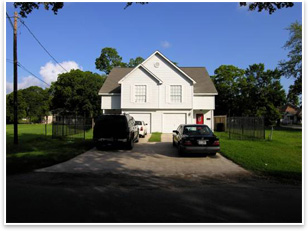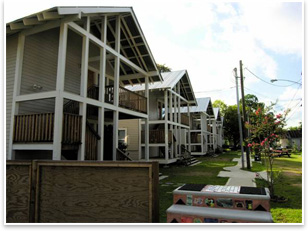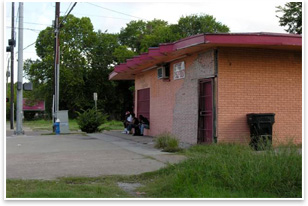Best Practices
Architects of Color Engaging in Collaborative Design
Houston’s Row House CDC provides some lessons for the country in collaborative design
by Louis B. Smith Jr., AIA
SPP Knowledge Community Chair
How do you . . . Inspire your community to see redevelopment possibilities?
Summary: In my experience, African-American and Hispanic architects seem disposed to participate in community redevelopment at some point in their careers. Some think this is because they have some inherent generosity as part of their character. Others believe it is the responsibility of the few to blaze a trail for the many. Some see it as paying back a debt to the forerunners. Others see it as paying it forward to the next generation. Since African Americans are a very small percentage of the profession, their participation in community building is as much an advertisement for what people in the community can become as it is for what the community as a whole can achieve. Antoine Bryant, of Houston, is a good example of a person who seems to have a bit of all of these items as motivation. It seems, though, that none of these really describes him. His motivation does not seem to come from any obvious source. I see what he has done in leading the community as a direct outgrowth of the skills he has as an architect. Here's a sampling of some of his skills.
 Vision: Color for the blind Vision: Color for the blind
Bryant, like other architects involved in community redevelopment, brings vision as the first and foremost characteristic of his service. Typical for architects and developers, he sees as much of what could be as he does of what is. That vacant lot is a townhouse or a single-family home or an apartment building waiting to be built—not just a piece of abandoned land with scrubby weeds growing in it. Often people in an economically depressed area take the absence of development over a period of years as a sign that there cannot and will not be development there—ever. Architect-visionaries have as their first duty changing that perspective.
Shown here is the renovated office of the Row House Community Development Corporation (CDC). Bryant, as he invited me in, told me that the building has a history of being referred to as Delia’s Lounge. It was in poor repair, vacant, and suffering from deferred maintenance when it was acquired by Project Row Houses and renovated by the Row House CDC. The painted acknowledgment on the front marks the building’s role as a past and future part of the neighborhood's story.
 Negotiation and team-building skills Negotiation and team-building skills
Community development does not happen by the actions of a single person; too many people are involved in the process for that. This was made clear to me on my visit, as Bryant referred constantly to the wide range of people and organizations that have all played a role in this redevelopment effort. As projects often include some government sponsorship or are subject to zoning and planning ordinances, the process is inherently political. Leadership, therefore, needs to be able to bring together people of different backgrounds and interests and incorporate them into a functioning team. This is a skill that many architects develop as they learn to operate in design studios and coordinate with consultants and clients. Clearly, it is a skill Bryant possesses. Most critical here is the ability to listen and understand the various values and perspectives.
Seeing alternatives
The training we architects receive in design makes us a valuable asset to the community development process. The political nature of the process often tends to wander toward fixed positions, rigidly held. Competing visions lead to acrimony and dissension. Each stakeholder sees its preferred solution as the only workable way. Architects, however, identify those parameters that can be bent, shifted, or adjusted. We specialize in seeing alternatives when others can’t. We then use this skill creatively to craft a new vision that supports enough of the underlying values of the parties to be a workable solution.
For Project Row Houses and the Row House CDC, this takes the form of renovating a series of historic rowhouses not into homes but artists' studios with the use of corporate sponsorship. In this case, Bryant reported to me that the vision came first from African-American artists from Texas Southern University, a historically black university, and the community. Architects became part of the process when the Rice Building Workshop (RBW) began to support the effort in the late 1990s. By 2003, the CDC determined that having a graduate architect on staff would be beneficial, and Antoine Bryant was selected. So although architects did not originate most of the projects undertaken by these two organizations, they have contributed to the overall success.
 Problem solving in context Problem solving in context
The context for community development is rarely auspicious; if it were, the community would not need any changes. The context of community development is economically shaky and physically demanding of time, money, political influence, planning, and design. It is just such an environment that enhances the ability to understand a situation’s context. Each player brings his or her own view. The banker sees development by its financial context. The planning commissioner sees from the legal perspective. The homeowner sees from the perspective of family safety and security, comfort, and advancement. The architect cannot simply see things from an aesthetic point of view. Architects must look at each aspect of development in its proper context and address the issues that arise in that context. Analytical skills are a large part of the answer. However, creative inspiration is the way to actually address the way these multiple contexts interact.
 The duplex shown here is among the first new market-rate housing to come into the neighborhood. It represents the double-edged sword of gentrification because although many area residents will not be able to afford such a dwelling, sustaining and improving value in the area depends on such projects. The duplex shown here is among the first new market-rate housing to come into the neighborhood. It represents the double-edged sword of gentrification because although many area residents will not be able to afford such a dwelling, sustaining and improving value in the area depends on such projects.
For balance, RBW designs the duplexes, which the Row House CDC builds using a local African-American general contractor. The units are based on other vernacular dwellings of the area reinterpreted in modern materials and aesthetics. They also make use of traditional structural systems, features, and proportions.
Creating new context
When the community development goals start to manifest, it creates a new context for the effort. We are familiar with design as a cyclical or iterative process. This is not the case for those who are not trained in design. By creating a new context at each level of development, the architect makes possible things that people inside the process could not imagine. This is critical, as the solutions to smaller problems often require larger issues to be addressed. Bryant has said that when he meets with people who want to participate in the process, his role is to describe to them the vision as it currently stands.
 The overall vision may require many smaller problems to be solved. The fabric of a neighborhood is not saved simply by the elimination or redevelopment of a single but significant blighted property. Removing the blighted property may be an important first step that shifts the context enough to allow for other actions. The renovation and improvement of many of the existing residential properties is far more important to the overall future of the area. Often, only when progress is made in the overall neighborhood quality can the vacant site from the blighted building become a critical development site. For instance, a vacant commercial building fewer than 200 feet from the CDC office remains a sign that there is still significant work to be done in the area. Its corner location makes it a highly visible concern. Still, on the whole, spending time in Houston’s Third Ward will convince even the most hardened cynic that there are solutions and that the Row House CDC, with Antoine Bryant’s participation, has found more than one way to succeed. The overall vision may require many smaller problems to be solved. The fabric of a neighborhood is not saved simply by the elimination or redevelopment of a single but significant blighted property. Removing the blighted property may be an important first step that shifts the context enough to allow for other actions. The renovation and improvement of many of the existing residential properties is far more important to the overall future of the area. Often, only when progress is made in the overall neighborhood quality can the vacant site from the blighted building become a critical development site. For instance, a vacant commercial building fewer than 200 feet from the CDC office remains a sign that there is still significant work to be done in the area. Its corner location makes it a highly visible concern. Still, on the whole, spending time in Houston’s Third Ward will convince even the most hardened cynic that there are solutions and that the Row House CDC, with Antoine Bryant’s participation, has found more than one way to succeed.
 It’s who you are, not what you do It’s who you are, not what you do
As far as leadership in the community goes, the issue is not what the architect’s role is. The issue is the architect’s skills and how they can be put to use. The roles can vary. Compensation mechanisms are simply part of the challenge. Being part of the community is part of the solution. It is unfortunate that in many cases architects have left a reputation in the community of not adequately listening. This tends to lower the credibility of the profession and creates a barrier to further architect participation. The barrier is surmounted not because of what the architect does. Rather, the success comes from living the persistence that arises out of the architect’s vision. Although it arises also from the skills that the architect brings to the table, it is not included in any drawing or any model. It cannot be depicted in any photograph or sketch or verbal presentation. The solution arises from who the architect is.
Be who you are in service to the world
Is Antoine Bryant’s story simply a nice thing to read while you surf the Net? Is it inspiration? Is it a glamorized fairy tale? You may think of it what you will. The results of reading this will manifest in your life. His story is not your story. You still have a story. It will arise out of who you are. Be who you are in service to your family, your neighborhood, your city, and your world. |


 Vision: Color for the blind
Vision: Color for the blind Negotiation and team-building skills
Negotiation and team-building skills Problem solving in context
Problem solving in context The duplex shown here is among the first new market-rate housing to come into the neighborhood. It represents the double-edged sword of gentrification because although many area residents will not be able to afford such a dwelling, sustaining and improving value in the area depends on such projects.
The duplex shown here is among the first new market-rate housing to come into the neighborhood. It represents the double-edged sword of gentrification because although many area residents will not be able to afford such a dwelling, sustaining and improving value in the area depends on such projects. The overall vision may require many smaller problems to be solved. The fabric of a neighborhood is not saved simply by the elimination or redevelopment of a single but significant blighted property. Removing the blighted property may be an important first step that shifts the context enough to allow for other actions. The renovation and improvement of many of the existing residential properties is far more important to the overall future of the area. Often, only when progress is made in the overall neighborhood quality can the vacant site from the blighted building become a critical development site. For instance, a vacant commercial building fewer than 200 feet from the CDC office remains a sign that there is still significant work to be done in the area. Its corner location makes it a highly visible concern. Still, on the whole, spending time in Houston’s Third Ward will convince even the most hardened cynic that there are solutions and that the Row House CDC, with Antoine Bryant’s participation, has found more than one way to succeed.
The overall vision may require many smaller problems to be solved. The fabric of a neighborhood is not saved simply by the elimination or redevelopment of a single but significant blighted property. Removing the blighted property may be an important first step that shifts the context enough to allow for other actions. The renovation and improvement of many of the existing residential properties is far more important to the overall future of the area. Often, only when progress is made in the overall neighborhood quality can the vacant site from the blighted building become a critical development site. For instance, a vacant commercial building fewer than 200 feet from the CDC office remains a sign that there is still significant work to be done in the area. Its corner location makes it a highly visible concern. Still, on the whole, spending time in Houston’s Third Ward will convince even the most hardened cynic that there are solutions and that the Row House CDC, with Antoine Bryant’s participation, has found more than one way to succeed. It’s who you are, not what you do
It’s who you are, not what you do